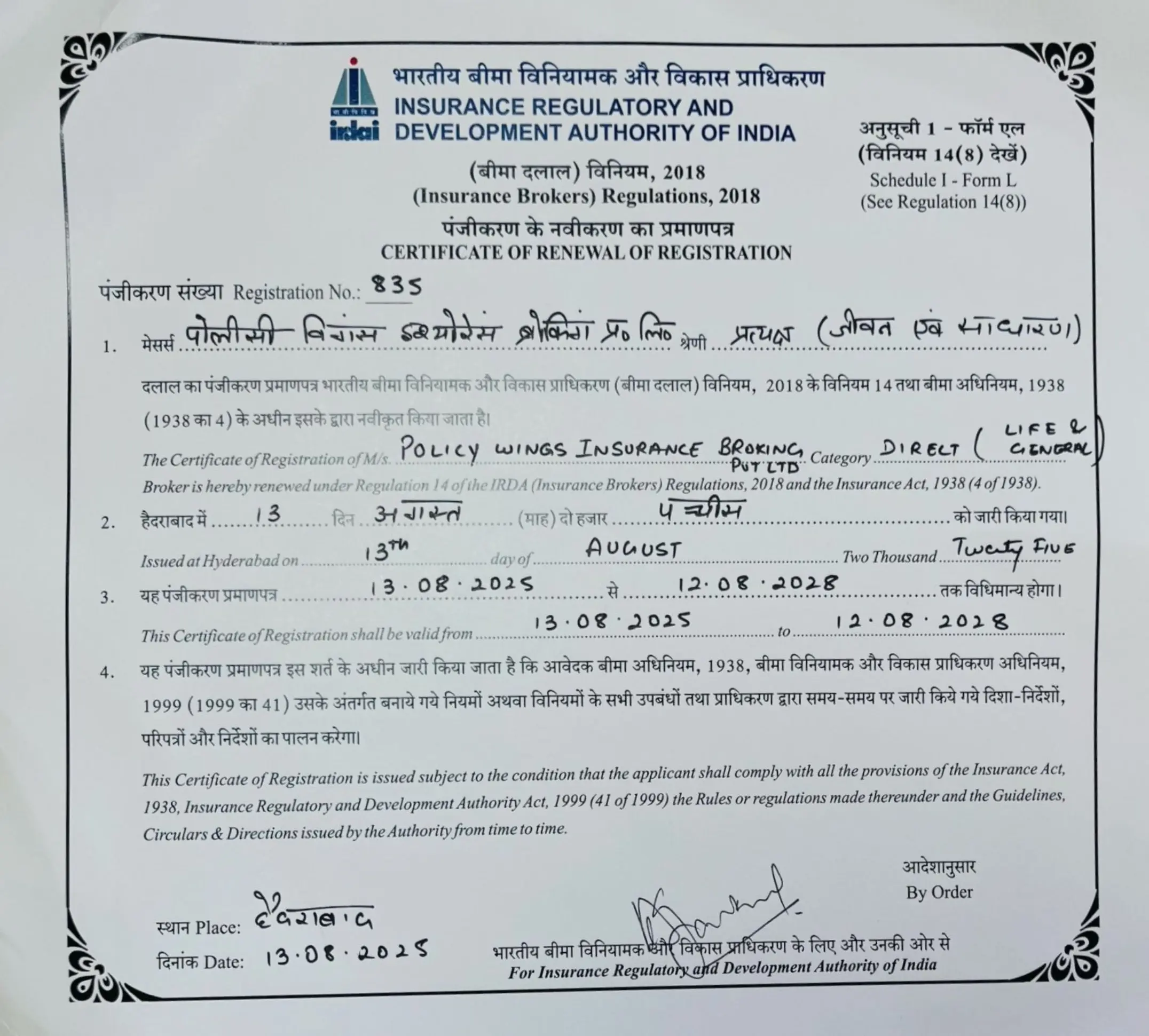Claim settlement process
Claim Settlement Process
The purpose of a health insurance policy comes into play when the insured is admitted to a hospital or suffers a medical emergency and has to pay for it. There is a term called a health insurance claim that occurs at that point if the hospitalization or the medical costs are to be paid for by the health insurance company at that point.
Any medical costs that arise as a result of a health insurance claim will be covered by the insurance provider if the claim is approved.
Although many people buy health insurance coverage, many do not understand how it actually works. People are generally concerned about the fact that an insurance claim will have to be made during the critical hospitalization period in order to receive benefits.
The main reason people buy health insurance is to be able to claim benefits when they are most in need of them. In order to be able to get the claim handled properly, one needs to be aware of how health insurance claims operate.
This article will discuss the types of health insurance claims and the process of settling the claims as they relate to health insurance.
Health Insurance Claims:
The purpose of buying a health insurance plan is to look for financial support that can cover the costs you have incurred throughout treatment. A claim is a formal request that aids in getting you the healthcare you need at the expense of your insurance provider. You only have to submit a claim to have the insurance provider cover the cost of your treatment.
The majority of health insurance policies require a hospital stay of 24 hours or more in order to file a claim. There are some plans that also include daycare coverage as well. To ensure that a claim is submitted and accepted quickly, you must make sure you understand and adhere to all claim-related regulations.
The timely payment of your health insurance premiums is also essential; otherwise, your coverage may lapse and your claim will not be processed.
Types of health insurance claims
There are two types of health insurance claims:


All about Cashless claim
A network hospital is a healthcare facility or hospital that has an affiliation with a health insurance provider to provide cashless treatment to policyholders.
Your insurance provider will directly cover all of the types of treatments and hospital stays that are covered by your plan. As the medical bill is immediately covered between the insurer and the hospital and the insured does not have to pay for the same, this is known as a cashless claim.
A list of hospitals that are part of the network of the health insurance provider is provided when you acquire a health insurance plan.
You wouldn’t be qualified for a cashless claim unless you were admitted to a network hospital. Both scheduled and emergency hospital stays are eligible for cashless claims.
Hospital stays can be costly, but a cashless claim facility spares you the hassle of scrambling to get funds at the last minute.
Advantage of cashless claim:
- The quick and straightforward procedure for filing a claim.
- You won’t have to worry about paying anything because your health insurance provider will cover all costs.
- No paperwork hassles as most of it would be taken care of by the hospital.
Disadvantages of cashless claim:
- In the event of an emergency that could be troubling, you are limited to getting care at a network hospital.
- Due to the need to fulfill all requirements, the release process may take some time.
The cashless claim settlement process:
- Notifying the health insurance provider is the first and most crucial step when claiming cashless health insurance. In the event of a planned hospitalization, you must make sure your claim request is registered as soon as possible, preferably before.
- You must complete and submit a Pre-Authorization/Claim Form after registering your claim in order to be approved for a cashless health insurance treatment.
This form may be downloaded from the TPA website or obtained from the hospital assistance desk. At least three to four days before the hospitalization, the form must be sent to the hospital.
You must make sure that your claim request is registered within 24 hours of being hospitalized, even in an emergency. - You may also request from the hospital an estimate of the cost of the care you will receive. This will enable you to determine whether the expense of therapy is sufficiently covered by your health insurance.
- If you have several health insurance plans and one’s coverage is insufficient, let the other insurance providers know so they can utilize your claim.
Check to see if there are any room sub-limits in your policy. If it is permitted by the rules, you may choose a shared room. - Only once your health insurance provider has given its permission, the hospital will offer you a cashless procedure. The hospital could require you to make an advance payment if the approval is delayed. The money will be returned to you after your request has been approved.
- Don’t forget to ask the hospital for the invoices and discharge summary to be forwarded to the health insurance provider when the treatment is completely completed.
- The claim compensated by the health insurance company would be evident after you received the final clearance.
You will be responsible for paying for the consumables and other costs if the insurance does not cover them. You can ask for reimbursement if you have other coverage that might cover these costs. - Pre- and post-hospitalization costs are only reimbursed at network hospitals.
Therefore, it is a good idea to have confirmed true copies of all of your bills and your discharge summary in case you decide to subsequently seek payment from another insurance company for the remaining balance.
All about Reimbursement claims:
As the name implies, with reimbursement claims, you must first pay the medical expenses out of your own money before you can request a reimbursement from your health insurance provider. Two circumstances are usual for this kind of claim:
- Health insurance policies that exclude cashless payments
- When you receive care at a hospital that is not in the network of cashless hospitalization.
Advantages of reimbursement claim:
- You can receive care at any hospital and afterwards be paid.
- A speedy discharge can happen as payment is done in cash.
- Along with your hospitalization claim, you can receive your pre-hospitalization and post-hospitalization claims.
Disadvantages of reimbursement claim:
- You first need to pay off all the debts, therefore you’ll need to make financial arrangements.
- Once you are dismissed, only then will you be paid back.
- There is a lot of paperwork required.
Reimbursement Claim Settlement Process:
- The most crucial step in requesting compensation, just like in a cashless claim, is notifying the health insurance provider. Make sure to register your claim request as soon as possible.
- Make sure to notify your health insurance provider at least three to four days in advance if you anticipate needing hospitalisation.
- In an emergency, be sure to register your reimbursement request within 24 hours of being hospitalised.
- All treatment expenses will be your responsibility to cover out of pocket.
- When you are prepared for discharge, don’t forget to bring all of the bills, receipts, reports, discharge summaries, etc. that have been confirmed true and stamped and signed by the hospital with you.
- You can submit a claim for compensation after you get home. A responsible friend or family member can assist you with the formalities if you are still recovering.
- The insurance provider must get all medical records, doctor certifications, and bills.
- The claim will be refunded once all the information has been evaluated and verified.
What are the documents required to make a claim?
- Cashless Claim:
When filing a claim with your health insurance, you must provide the following papers; attempt to keep them all in one location. Your family members should also be aware of them so that, should you ever end up in the hospital, they will know exactly where to find all of the relevant paperwork.
a) Health or Policy Card of the Insured Person Receiving Treatment and KYC documents.
b) Pre-authorisation form duly filled.
c) Doctor’s advice for hospitalization.The rest of the documents would be provided by the hospital such as:
d) Reports of analytical and diagnostic tests—CT scans, ultrasounds, X-rays, blood reports, etc.—duly completed.
e)In the event of an accident, a copy of the police report and a medico-legal certificate, as well as prescription drug receipts and invoices and diagnostic test reports with a discharge summary mentioning the exact line of treatment. - Reimbursement Claim:
At the time of filing your reimbursement claims, you need to file the documents serially for the insurer/TPA to process your claim smoothly. Documentation is the most important part of the process for reimbursement claims:
a) Health or Policy Card of the Insured Person Receiving Treatment and KYC documents.
b) Copy of the claim intimation sent via letter or email.
c) Completely filled out and signed the claim form, doctor’s consultation papers, your account information for the reimbursement transfer, and KYC documents along with the copy of the cancelled cheque of the policyholder for the transfer.
d) Original receipts and invoices for prescription medications
e) Original reports from investigative and diagnostic testing, such as blood tests, CT scans, ultrasounds, and X-rays, etc.
f) A summary of the FIR and medical-legal certificate regarding discharge in the event of an accident.
g) Discharge summary mentioning the exact line of treatment.
How does the health insurance claim process work?
Your insurer charges you a premium in exchange for financial security in the event of any unanticipated medical costs.
The act of notifying your insurer of a medical bill so they may reimburse you in accordance with the terms and conditions of your insurance policy is known as filing a claim. According to the terms and circumstances outlined in the policy, the insurer is responsible for paying your hospitalisation expenses.
You can submit a claim via the cashless or reimbursement process against your health insurance plan.
When you choose a cashless claim, the Third-party Administrator’s (TPA) job is to work with all parties involved to settle your claim in accordance with the policy’s terms and conditions.
However, to begin the reimbursement process, you must file a claim directly with your insurance provider, either online or by mail.
Points to remember about health insurance claims
When filing a claim under their health insurance, the insured should exercise caution with regard to a few key issues. These considerations aid in the quick and easy resolution of claims. The following are the points:
A. Required Documents:
Other important documentation would be needed when filing a claim in addition to the pre-authorization form and the original medical bills and reports. They consist of the following:
a) A current ID of the insured
b) A copy of the policy bond and bills for any equipment utilised in the operation
c) Cancelled cheque
d) Whatever further paperwork the insurance provider may ask.
B The maximum sum insured:
Only the sum insured limit that the insured has selected applies to the admissibility of health insurance claims. The excess would need to be paid by the insured if the claim was more than the amount covered. Therefore, the insured should examine the health insurance policy’s sum insured limit.
C. Exclusions:
There are several situations that health insurance coverage does not cover. Generally, this refers to exclusions. A claim would be denied if it was submitted for an excluded expenditure. Therefore, it is advisable to review the plan exclusions before filing a claim to avoid filing one for an excluded item.
The insured would be aware of the reason for rejection even if the claim was lodged and later denied.
D. Timeline:
In the case of a cashless claim, there is a deadline for submitting the pre-authorization form. The pre-authorization form must be filed three to four days in advance for scheduled hospitalisation and within 24 hours for emergency hospitalisation. To be eligible for cashless claim settlements, compliance with certain deadlines is required. The claim may be delayed if the deadlines are not met.
E. Hospital network list:
Only when treatments are received in a hospital that is part of a network is a cashless payment of a claim conceivable.
Therefore, before receiving treatment, the insured should check the list of affiliated hospitals if they desire to use the cashless claim service. The list is conveniently available online and on the website of the insurance provider.
F. The insurance policy’s continued efficacy:
Only when health insurance coverage is active and has not expired are claims paid out. The claim would be denied if the insurance had expired. As a result, the insured should make sure the policy doesn’t expire in order to benefit from quick claim payments.
Steps to File a Health Insurance Claim Form:
- Planned hospitalisation:
a) At least five days prior to the scheduled treatment date, you must mail or email the cashless claim form to your insurance.
b) When the insurance provider receives your cashless claim form, they will notify the hospital.
c) A letter of confirmation will be sent to you, and it will be good for seven days starting from the date of issuance.
d) Before being admitted, submit the confirmation letter and health card. The insurance provider will cover your medical costs. - Emergency hospitalisation:
a) Within 24 hours after being hospitalised, you must tell your insurance company or third-party administrator. You will receive a claim notification and reference number.
b) Your cashless claim form should be completed and sent by the hospital to your insurance.
c) After receiving your cashless claim form, the insurance company will send authorization to the hospital.
d) The insurance provider will cover your medical costs. You will be notified via both your registered cellphone number and email address if your claim is denied.
How do you check the status of your health insurance claim?
You can check the status of your health insurance claim in multiple ways. For cashless hospitalisation, you can contact the TPA or the insurance desk of the insurer or call the call centre of the insurer with your claim reference ID for the exact status of the claim. Also, you can track the status of your claim online through the official website of the insurer or the TPA or through your mobile application.
For reimbursement claims, you need to either call the call centre of the insurer or the TPA or track it online or through the mobile application with details of your claim such as the claim reference number.
For escalations and delays, there would be an escalation matrix provided by each insurer which could be referred to.
Top 4 reasons for rejection of Health Insurance Claims:
You must have overheard people lamenting the denial of their health insurance claim. Have you ever wondered why someone might reject you?
In order to receive the required help from your health insurance provider, you should avoid making the following typical errors that might result in the claim form being rejected:
- Reason 1: Incomplete Process:
This is one of the most common types of rejections when the form is not filled properly. Before submitting a claim, you must fully understand the regulations that each health insurance provider has established for itself.
How to avoid it?
Contact a corporate executive from your health insurance provider if you have any questions. The form can be rejected if you submit it with errors or depart from the company’s protocol. - Reason 2: Understanding the waiting period:
If there is a waiting period specified in the policy document for a specific ailment, then the claim would not be admitted.
For example, a health insurance provider has a waiting period before paying out maternity benefits. Therefore, if you submit a claim within the waiting period, it will be denied.
How to avoid it?
Read the terms and conditions of the policy before opting for the plan and filing the claim so that you are completely aware of your rights. - Reason 3: Lapsed policy:
Health insurance plans are usually one-year contracts. So, if you wish to continue your health insurance coverage, you need to pay the due premium on time and renew your plan to receive continuity benefits. Your claim could be denied if your policy is not renewed on time.
How to avoid it?
Remember to renew your policy on time. Opt for standing instruction or ECS (Electronic clearing system) so that your policy validity continues. You can also opt for a long-term policy renewal of 2 or 3 years so that you do not have to pay your premium every year. - Reason 4: Exclusions:
Each health insurance policy has a specific list of exclusions mentioned. If you file a claim listed as an exclusion, your claim would be denied.
How to avoid it?
Know all about the policy exclusions so that you are well aware of the list of exclusions before filing a claim.
If you read the terms and conditions of your health insurance policy, declare your health conditions clearly before opting for the policy and follow the process and submit all relevant documents on time, your claim would surely be admitted without any hassle.
Conclusion
You are financially protected against any unanticipated medical emergency with health insurance. It is very important these days to ensure that you and your whole family have an insurance policy. One must compare different plans and policies in order to buy the most suitable one.
Frequently Asked Questions
Settlement of claims without the use of cash is simple and convenient. One may use the cashless claim if the hospitalisation is arranged and the treatment is provided in a network hospital. However, one might choose to file a reimbursement claim in cases of emergency if they don't have time to examine the list of network hospitals or if the therapy isn't offered there.
A health insurance claim can be settled with several different insurance providers, yes. In the event of a claim, all insurance companies should be notified, and the necessary paperwork should be given to each insurer.
Services, administrative fees, and expenses for an additional bed, washing, syringes, and other items are among the expenditures that are not covered by the insurance. See your insurance policy for further details on exclusions.
Yes, your insurance coverage does include a waiting period. With the exception of an accident, you often have to wait 30 days before you can submit a claim. Additionally, there is a waiting period for pre-existing problems and certain illnesses.
Depending on the insurance, this could change. So, verify with your insurance provider to prevent unpleasant surprises when it comes to settling claims.
Leading Health Insurance Companies





Latest Blogs
Introduction Small and medium enterprises (SMEs) are the support systems of India’s economy which contributes nearly 30% to the GDP and employs millions across diverse sectors and still one of their biggest challenges lies in managing cash flow disruptions caused by delayed payments or outright defaults from buyers. In a cut throat market where access to credit is limited, even one unpaid invoice can hamper an SME’s financial stability. This is exactly when credit insurance in India comes into light as a strong safeguard providing trade credit protection to reduce risks and strengthen business security. Understanding Credit Insurance Credit insurance can also be termed as trade credit insurance or accounts receivable insurance which is a risk management instrument that secures businesses from losses arising due to failure of payment by buyers. If a customer fails due to insolvency, bankruptcy or prolonged delays then the insurer compensates the policyholder for a large portion of the outstanding dues. In the Indian framework, credit insurance provides a protection where delayed payments are a constant concern particularly for SMEs engaging with large corporations or overseas buyers. It makes sure that if a buyer fails to pay even then the business does not face sudden financial stress. Requirement for Trade Credit Protection for SMEs Cash Flow Stability: SMEs usually operate on low budgets and limited reserves. Even one default can interrupt working capital cycles which can make it hard to meet payroll or pay suppliers. Trade credit insurance helps maintain liquidity. Risk Variation: SMEs can benefit from the insurer’s risk assessment expertise which decreases exposure to high risk buyers instead of depending only on internal credit checks. Business Expansion: SMEs can assuredly extend credit to new customers and enter foreign markets including exports with the assurance of credit protection. Improved Borrowing Capability: Banks and financial institutions are more inclined to lend when receivables are insured which can increase the chances of SME’s access to credit. Growth of Credit Insurance in India Over some years, acknowledgement of credit insurance has grown due to rising trade volumes and payment uncertainties. The pandemic further made us focus on the significance of securing receivables as many businesses faced unexpected disruptions in buyer payments. Regulatory support from the Insurance Regulatory and Development Authority of India (IRDAI) has also played a significant part. Guidelines have been amended to make trade credit insurance more reachable to SMEs making sure that they can have coverage without complex procedures. Working of Credit Insurance The SME goes to an insurer or broker to purchase a credit insurance policy. The insurer checks the creditworthiness of the SME’s buyers. A coverage limit is given to each buyer which defines the maximum insured amount. If these’s a default then the SME submits a claim with supporting documents. After verification the insurer compensates a huge percentage of the loss which usually ranges between 75% and 90%. General Benefits for SMEs The most important benefits of credit insurance is recovering unpaid invoices but some extra advancements include: Stronger Negotiation Ability: Insured receivables provide SMEs with significant leverage when negotiating with banks or investors. Global Market Access: trade credit insurance for exporters serves as a safety net against foreign buyer risks, political instability and currency related payment problems. Operational Confidence: entrepreneurs can focus on productive strategies with less financial anxiety rather than tracking overdue payments. Improved Corporate Governance: Insurers often provide insights and data on buyer performance, helping SMEs build disciplined credit policies. Challenges in Adoption Credit insurance in India is still not effectively used despite its benefits. Several elements contribute to this void like: Low Awareness: Many SMEs are not familiar with trade credit protection or assume it is relevant only for big corporations. Perceived Costs: Business owners usually see premiums as an extra cost without acknowledging the potential savings from avoided losses. Complicated Terms: Insurance terms and procedural requirements may put off smaller businesses from exploring policies. Future Expectation for Trade Credit Protection in India The requirement for credit insurance in India is expected to increase gradually due to these reasons: Growing Trade Networks: SMEs will require protection against foreign buyer risks with India’s rising exports. Digital Development: Online platforms are making insurance products more reachable and customisable. Government Initiatives for SME Growth: Policy initiatives such as ‘Atmanirbhar Bharat’ and inducements for exporters will navigate demand for financial protections. Increased Banking Integration: Banks may promote insured receivables as part of lending conditions further which can normalise trade credit protection. Conclusion The risk of buyer defaults is a financial inconvenience and a survival challenge for SMEs in India. Credit insurance in India gives a strong solution by making sure there is trade credit protection, balanced cash flows and encouraging business confidence. Credit insurance will become a necessary part of SME risk management in coming years while challenges in awareness will still remain complex.
...Introduction With India urbanizing so quickly, the commercial property insurance landscape particularly in the commercial sector has undergone a major change. With cities expanding, real estate development is rising and businesses increasingly exposed to natural and man made disasters are driving record demand for commercial property insurance which is reaching unmatched levels. This part of insurance has shifted far behind just asset protection and has become an important part of risk management for enterprises navigating today’s urban challenges. Rising Demand for Business Property Coverage As India’s business centers grow, the chance of damage from fire, floods, earthquakes, theft and cyber attacks increases. The rise in climate related events has made city properties more at risk. Because of this the business property insurance is now needed for all businesses from small stores to big factories. A big change is that there are more businesses that are buying policies that cover not only buildings but also equipment, stock and business interruption. This complete approach shows that companies understand that the business disruptions can cause bigger financial losses than the cost of fixing physical damage. Regulatory Oversight and Policyholder Protection The Insurance Regulatory and Development Authority of India (IRDAI) guides India’s insurance rules. These rules emphasize clear information, fair pricing and quick claim settlements. Policies have to follow strict rules about what they cover to avoid arguments. For cities facing high risks there is an additional cover option such as earthquake or terrorism protection which are commonly advised. Recent court cases show the legal issues that can come up in business insurance disputes. In some cases before consumer commissions and High Courts the insurers had to pay claims because they rejected them using unclear exclusions or not fully explaining the policy. Courts have said many times that insurance contracts must be handled with honesty and that insurers should interpret policies in a way that benefits the policyholders. This legal trend makes it easier for businesses to get compensation and makes insurers more responsible for handling claims quickly and honestly. Urban Risks Driving Policy Growth India’s urban centers face a wide spectrum of risks and insurance adoption is rising accordingly: Natural Disasters like Flooding in metro regions and seismic risks in northern and northeastern states demand specialised coverage. Densely packed industrial and commercial areas have more fire risks so fire riders are important. Because property crimes are up in cities there is a greater need for protection of inventory and buildings. Since businesses rely on being open all the time then even brief shutdowns can lead to big losses which makes business interruption coverage very important. Urban businesses are realizing property insurance is a necessity rather than just an option because of the risks involved. Digital Change in Commercial Property Insurance Commercial property insurance in India has changed because of digital platforms and AI based risk assessment. Tools can now check how strong buildings are and also location based risks even the weather patterns so insurers can set policy prices better. For those with policies the digital claim systems cut down on paperwork and speed up payments. Also devices like fire sensors and security systems are being added to insurance plans. Companies that use these tools to lower risks often get lower premiums which encourages them to take safety steps. Legal Consequences and Responsibilities Business insurance regulations have a few important responsibilities for insurers and policyholders: Insurers: If an insurer mistakenly denies a claim they may face penalties under consumer protection laws. Courts may also order compensation for emotional distress and legal fees on top of requiring the claim to be paid. Policyholders: If a policyholder does not disclose all important information like previous damage or poor safety procedures, their claims may be rejected and they could face legal action. It is critical to be honest and meet all policy demands. Duty of Good Faith: Courts have confirmed that both sides of an insurance deal have to act honestly and if they don’t then they can be sued and lose money. Strategic Considerations for Businesses Businesses in cities should do risk assessments that look at both building risks and location related risks when picking insurance. Think about using extra coverage options: Things like coverage for natural disasters, theft and business problems can add important protection in cities. Follow the law and be honest when you apply and follow safety rules you can avoid problems with claims and get better insurance options. Use of technology: Prevent problems like fire systems as they have security cameras and they keep monitoring tech which can lower risks and also even lower your insurance costs. Keep up with legal news: Knowing about court decisions can help you be ready for possible legal arguments. Conclusion Commercial property insurance in India has evolved because of the digital platforms and AI based risk assessment. By 2025 the business property insurance will be an important part of how companies in India deal with the risks of fast-growing cities. The higher need for this kind of insurance shows that risks are increasing and that people know more about how insurance can protect them financially. Because rule makers want things to be clear, courts are protecting the rights of people with insurance and technology is making coverage smarter. Property insurance is becoming a main part of keeping businesses going. For businesses it’s vital to pick complete policies, follow the rules and take steps to prevent problems in cities.
...Introduction Finding cheapest property insurance India doesn’t mean you should sacrifice protection. For homeowners, landlords and small business owners, low cost property insurance and budget property insurance India options exist but the trick is to balance premium savings with meaningful cover. This article for Policywings explains how to get affordable cover, what to watch for and the recent regulatory changes that affect buyers. What “cheap” should really mean Cheap should mean “cost effective”, not “thin”. A low premium is attractive, but policies that exclude common perils or skimp on sums insured can leave you with large out of pocket losses. Look for a policy that covers both the building (structural damage) and contents (furniture, appliances) and check addons for important risks like flood, earthquake or theft. Consider replacements vs. indemnity bases, replacement cost cover costs more but avoids depreciation disputes at claim time. How insurers keep premiums low Insurers reduce premiums by using narrower cover, higher deductibles (excess) and risk based pricing. You’ll often find cheaper annual premiums if you: Raise the deductible (you pay more for small claims). Limit cover to specific perils (e.g. “fire & allied perils” vs. “all risks”). Install basic safety measures like smoke alarms, burglar grills or approved fire extinguishers and declare them when buying a policy, since many insurers offer discounts. Buy multi year or family/group policies, where available. Practical tips to find the cheapest policy without underinsuring Compare insurer quotes on Bima Sugam and major aggregators, but always verify product wording before buying. Bima Sugam aims to make offerings transparent and comparable. Calculate correct sum insured: undervaluing your property gives cheap premiums but leads to shortfall at claim time; overvaluing wastes money. Choose sensible addons only for example, include flood cover if you live in a flood prone region; skip niche riders you don’t need. Keep records like photographs, receipts and property plans speed up claims and reduce disputes. Recent regulatory changes and compliance you must know The insurance regulator has been active with new regulations in recent years, focused on product clarity, consumer protection and digitisation. In 2024-2025 the IRDAI updated consolidated regulations that affect product filings, solvency and policyholder protection; these set higher standards for product disclosures and grievance handling by insurers. Buying via regulated marketplaces and insurers that follow IRDAI product wordings helps ensure more consistent protection. In addition, the regulator has promoted Bima Sugam, a centralised electronic marketplace to improve choice and transparency for retail buyers, which can help you compare low cost property insurance plans more reliably. There are also active policy discussions and pilot ideas on climate linked and parametric insurance for disaster payouts, which if implemented nationally could change how flood and cyclone risks are priced and paid out. This is particularly relevant for property owners in climate vulnerable areas. Finally, IRDAI has been strengthening grievance resolution mechanisms; draft proposals include in-house ombudsman concepts to speed internal complaint redressal before escalation to external forums. This improves consumer protection when buying even budget policies. What to check in the policy document (must read clauses) Perils covered/excluded: floods and earthquakes are often excluded unless expressly added. Sum insured and basis of settlement: indemnity vs. replacement basis. Deductible/excess: higher deductibles lower premium but increase your exposure for smaller losses. Sub limits and depreciation: watch for limits on specific items (electronics, jewellery) and depreciation tables that reduce payouts. Claim process and timelines: look for insurer commitment on turnaround times and documentation requirements. When cheapest is NOT the right choice If your property is in a high risk zone (coastal, floodplain, seismic), buying the very cheapest plan may leave you exposed to catastrophic loss. Similarly, landlords with rental liability exposures or owners of high value contents should prioritise adequate limits and liability cover over lowest premiums. Quick checklist before you buy Verify the insurer is IRDAI registered. Read the product brochure/wording not just the marketing blurb. Check claim settlement ratio and sample claim timelines if available. Ask about discounts (multi year, security device, salaried). Keep an inventory with photos and proofs. Conclusion Affordable property protection in India is achievable with a disciplined approach: choose the right cover, use regulated comparison channels and stay informed about regulatory changes that improve transparency and claims handling. Policywings recommends prioritising correct sums insured and essential covers (fire, flood where needed and liability) because genuine value lies in the policy’s ability to restore your life after loss, not only in the premium paid.
...Introduction Understanding how much car insurance costs in India and how insurers arrive at that car insurance price can save you money and stress. This guide explains what drives premiums, how to use a car insurance premium calculator, recent regulatory changes you must know and practical ways to compare and reduce your vehicle insurance cost India wide, written for Policywings readers who want fast, actionable clarity. What determines your car insurance premium Insurers price policies based on predictable risk drivers and choices you make when buying cover. Key factors are: Insured Declared Value (IDV): the vehicle’s current market value. Vehicle age, variant and make: luxury or performance cars cost more to insure. Cubic capacity/power and usage: private vs commercial usage affects third party rates. RTO location and registration details: premiums vary by city/zone. Claim history and No Claim Bonus (NCB): a claim free history lowers the own damage premium. Addons and deductibles: extras like zero depreciation or road side assistance raise premium; higher voluntary deductibles lower it. These factors are built into online car insurance premium calculators offered by insurers and aggregators to give instant estimates. Use them to run multiple scenarios (change IDV, addons, voluntary excess) so you can compare apples to apples. How third party and comprehensive premiums differ In India you buy either: Third party liability cover: mandatory by law; it covers legal liability for damage to others. Comprehensive (third party and own damage): includes repair/replacement for your vehicle (subject to deductibles and exclusions). Third-party premium rates are set by government notifications (in consultation with IRDAI) and often published as standardized rates for different engine sizes and vehicle classes. Own damage pricing is underwritten by insurers, so this is where most premium variation occurs. If you want the lowest car insurance price, compare the own damage component across insurers while ensuring the third party meets statutory requirements. Recent legal and regulatory updates every buyer should know Regulation in motor insurance has evolved to increase transparency and consumer protection. Important recent points: Multi year third party requirement for new vehicles: regulators and central government guidelines have promoted offering long term third party covers (for example three years for new private cars and five years for two wheelers) as standard options at purchase; own damage cover can be bought annually or as per insurer offerings. This affects upfront car insurance price calculations for new registrations. Standardisation of certain rules: IRDAI initiatives have pushed for uniform No Claim Bonus grids and clearer claim handling timelines which can reduce variability between insurers for those elements of premium calculation. Government-set third party tariffs: the Ministry of Road Transport and Highways (in consultation with IRDAI) notifies third party premium slabs; these remain outside an individual insurer’s pricing freedom. Expect changes when such notifications are updated, especially in response to inflation or claim trends. Recent judicial developments: courts have clarified aspects of who can claim under motor insurance and liability interpretation in accident cases; such rulings can influence claim outcomes and thereby affect insurer pricing over time. Keep an eye on major judgments that may broaden compensable heads or alter settlement practices. Use a premium calculator: the right way An effective car insurance premium calculator does more than spit a number. To get useful quotes: Enter exact vehicle make, model, variant and registration year (mismatches produce wrong IDV). Try at least three different IDV settings (market value, slightly lower, slightly higher) to see premium sensitivity. Toggle addons and voluntary deductibles to understand incremental cost for each benefit. Compare results from an insurer’s calculator and an aggregator: aggregators show side-by-side options quickly, insurers’ calculators sometimes reflect exclusive offers. Aggregators and insurer calculators are widely available and free; use them to shortlist 2 to 3 policies before buying. Practical tips to lower your vehicle insurance cost in India Maintaining and claiming judiciously: preserving NCB yields the single biggest discount on the own damage portion. Opt for higher voluntary deductibles if you can afford small repairs out of pocket. Avoid unnecessary addons, buy only what you will use. Fit approved antitheft devices and inform the insurer: some companies offer OD discounts. Bundle policies (home and car) with the same insurer if discounts apply. Compared at renewal: switching insurers can save money but ensure portability of NCB and check exclusions. Conclusion Confirm whether your new car needs a multi year third party policy at purchase and how that affects upfront cost. Verify IDV and inclusions for total loss/theft scenarios (ask how RC cancellation is handled in write offs). Check the fine print for sub limits (engine, electrical parts) and depreciation tables. Keep documents that prove past NCB and claim history: concealment can lead to claim repudiation. Getting the best car insurance price is mostly about comparison and a few smart choices: use premium calculators to model scenarios, understand the split between statutory third party costs and insurer priced own damage premiums and stay updated on regulatory changes that affect policy duration and claim handling. Policywings recommends running at least three online quotes and reading the policy wordings before you commit, small differences in addons and IDV can change your outlay significantly at the time of claim.
...Introduction In today’s digital age, e-commerce has become a support system for market growth in India but the opportunity comes with risk. For any online business, securing the right insurance cover is important to protect assets and navigate evolving legal regulatory compliance. Requirements of E-commerce Insurance Having an online business means having more layers of risk than many realize and these risks can be product defects, data breaches, shipping damage, intellectual property claims and regulatory exposure. Without adequate insurance, a single legal claim or regulatory penalty can gravely damage finances or harm reputation. Ecommerce insurance India isn’t just a protection but in many cases it becomes a legal requirement under consumer protection rules, data protection laws, product safety regulations, etc. Risk Covers Every Online Business Should Know About: Product Liability Insurance: you can be held liable for damage caused by defective products when you sell goods from third party suppliers as well. Under the Consumer Protection Act 2019, sellers and service providers can face product liability claims for injury, damage or death caused by a product even if you don’t manufacture it yourself. General Liability Insurance: This covers third party bodily injuries and property damage caused by business operations. For example a customer coming to your warehouse/store or damage caused during delivery handled by you, etc. Professional Liability/Errors and Omissions Insurance: If your business offers services (like custom printing, consulting or design) or misrepresents product features (e.g. advertising claims), mistakes or omissions can give rise to legal action. This insurance helps cover legal defence costs, settlements or regulatory fines. Cyber Liability Insurance: Given that nearly every e-commerce business processes personal data, payment information or maintains customer-facing platforms which can lead to real threats like incidents of hacking, data breach or ransomware. Cyber insurance covers breach notification costs, liabilities arising from loss, misuse of data and even business interruption arising from cyber incidents. Business Interruption Insurance: Disasters (like natural calamities, fire, flood), technical failures or cyber attacks can drive an e-commerce company to discontinue operations. Business interruption cover helps replace lost income, pay fixed costs which can help you survive through downtime. Cargo/Transit/Shipping Insurance: Goods in transit are exposed to damage, theft or loss. For e-commerce companies depend significantly on logistics and delivery and mainly with third party carriers then shipping or cargo insurance can protect your goods until they reach the customer or warehouse. Commercial Property/Inventory Insurance: If you maintain warehouses or stock inventory then physical threats like fire, theft, natural disasters can cause huge losses. Covering property, inventory and equipment is important. Regulatory, Fines & Penalties Insurance: You may face regulatory penalties (under data protection law, consumer protection rules or standards violation) as laws are strengthened. Some insurance products are starting to cover penalties or legal compliance costs. Legal Changes & Compliance Trends Influencing Insurance Requirements Consumer Protection Act, 2019 & Product Liability: The Act introduced a statutory product liability establishment (Sections 82 to 87) which obligates manufacturers, sellers, service providers to compensate consumers for damage or harm caused by defective products. Sellers on e-commerce platforms (inventory model or marketplace model) are included particularly where they have exercised control on labeling, packaging, storage, inspection or warranties. Consumer Protection (E-Commerce) Rules, 2020: These Rules require e-commerce platforms to set forth certain information (like return policy, refund policy, warranty, guarantee, country of origin or expiry dates) and to abstain from unfair trade practices. Noncompliance can cause penal action. This raises exposure to legal risk for online businesses. Bureau of Indian Standards (BIS) Compliance/Quality Control Orders: BIS enforcement actions in 2025 have included seizure of products stored in warehouses of e-commerce giants that lacked needed certification. This establishes that platforms and sellers can be held liable even before sale. Making sure product safety and conformity is mandatory. Digital Personal Data Protection Act, 2023 (DPDP Act) (Not fully in force in certain respects but it’s important): This law imposes obligations on “data fiduciaries” (entities collecting/processing personal data). Main provisions include consent, purpose limitation, data subject rights and penalties can be very high for serious breaches. E-commerce businesses require reexamination of data collection, retention and data breach response. This raises cyber/privacy risk notably. Proposed Amendments to E-Commerce Rules: Draft changes include making registration with DPIIT required for all e-commerce entities (which also includes foreign entities that want to operate in India), enhancing related party seller restrictions, extra duties on identification and transparency. Noncompliance risk increases when these come into effect. Strategic Approach for Building an Insurance Portfolio: Start with main covers like product liability, general liability, cyber & property insurance. Add secondary covers like transit/cargo or professional liability and when scale rises then add regulatory risk as optional addons. Team up with insurers who understand e-commerce and those who know marketplace models, cross border shipping and digital assets. They will understand your risk profile much better and provide adequate cover instead of typical covers. Time to time review insurance as business grows: more SKUs, higher sales, more complex logistics or international clients will change exposure and may require more limits or new covers. Conclusion Ecommerce insurance in India is a strategic move and legally essential. With laws like the Consumer Protection Act 2019, Consumer Protection (E-Commerce) Rules 2020, BIS Quality Control Orders and the upcoming enforcement of the DPDP Act, your risk dangers are rising. The right insurance portfolio that includes product liability, cyber risk, general liability, business interruption, cargo transit and more will protect your business and also build trust in consumers and partners.
...Introduction Buying car insurance is no longer just about ticking the “third party” box. Many owners today evaluate addons such as bumper to bumper (commonly called “zero depreciation”) to reduce out of pocket repair costs. But what happens once your car crosses the 5 year mark? This article explains zero depreciation insurance eligibility in India, what IRDAI endorsed wordings say and whether bumper to bumper insurance after 5 years is a smart buy, specifically for Policywings readers who want clear, practical guidance. What “bumper to bumper”/zero depreciation actually covers Bumper to bumper and zero depreciation addons are designed to eliminate the depreciation deduction applied during claim settlement for replaced parts, especially plastic, rubber and fibre components that wear out fast. In plain terms: if you have the add-on and your claim is admissible, the insurer pays the part replacement cost without deducting the normal depreciation. This improves claim value but increases your premium at renewal. Age limits and regulatory wording you should know There is no single nationwide rule that every insurer follows; eligibility depends on insurer product rules and the specific addon wording. However, many major insurers cap zero depreciation eligibility to the earlier years of the car’s life (typically up to 5 years). At the same time, IRDAI endorsed endorsement wordings used by public insurers sometimes specify different age slabs for example, a nil depreciation endorsement used by Oriental Insurance states cover is available for vehicles whose age is less than or equal to 6.5 years on policy inception and limits certain claims to the first two partial loss claims in a policy year. That demonstrates insurer discretion and differing product design. Is bumper to bumper available after 5 years in India? Short answer: sometimes. Most insurers stop offering traditional zero depreciation addons once a car is older than 5 years, but some insurers extend similar covers to older vehicles with conditions (higher premium, limited claim count or capped parts). A few market players advertise options up to 7 or even 10 years for “bumper to bumper” type covers, but those products are rarer and usually more expensive. Always confirm the exact eligibility at renewal, because availability varies by insurer and by the addon wording. Recent regulatory or compliance notes (what changed and what matters) IRDAI continues to standardize endorsements and expects insurers to disclose addon limits, age slabs and exclusions clearly at the point of sale and renewal. The Oriental Insurance nil depreciation endorsement is an example of a standardized wording that spells out age calculation, claim limits and exclusions, a useful template that other insurers echo. Also remember third party liability insurance remains legally mandatory under the Motor Vehicles Act; addons are voluntary enhancements to your comprehensive cover, not substitutes for statutory protection. Practical checklist: should you buy bumper to bumper after 5 years? Consider your car’s IDV (insured declared value). If the IDV is already low, a higher premium for zero dep may not give proportional benefit. Evaluate typical claim cost. If most past claims on your model involve plastic/fibre parts (bumper, headlights, trims), zero dep can save materially. Check limits: some policies restrict zero dep to the first one or two partial loss claims per year, read the renew offer carefully. Compare alternative addons: glass cover, engine protection and consumables cover may be cheaper and address the exact exposures you face. Factor in No Claim Bonus (NCB) and deductibles, a frequent small claim could erode NCB benefits and make the addon less attractive. When it’s usually worth it Bumper to bumper is cost effective when: the car is driven in high risk environments (city traffic, rough roads), replacement parts for your model are expensive and you value cashflow certainty for repairs. For cars with higher cosmetic replacement costs (modern plastic bumper assemblies, advanced headlamp units), the addon often pays back quickly in a single mid sized claim. When to skip it If your vehicle’s IDV is low, you drive sparingly, repairs are usually minor or your budget prioritises keeping premiums down, skip the addon or look for targeted covers (glass/engine/consumables) instead. After 5 years, many owners find targeted riders offer a better premium to benefit ratio. How to shop at renewal Ask insurers explicitly about “bumper to bumper insurance after 5 years India” options and get the precise endorsement wording. Compare at least 3 proposals for premium, claim limits and exclusions. Confirm whether mid term inclusion is allowed (many endorsements prohibit mid term additions). Keep record of prior claims and NCB, they affect pricing. Conclusion Bumper to bumper (zero depreciation) after 5 years can be available but is not universally offered; when it is, it often comes with stricter terms and higher cost. The decision should be pragmatic: weigh IDV, typical repair costs for your car model, claim frequency and the exact addon wording at renewal. For many 5+ year cars, targeted addons deliver more value than a blanket zero dep but if you drive in risky conditions and parts are costly, a carefully chosen bumper to bumper option may still be worth the premium. Always read the endorsement wording before you buy.
...Introduction Mergers & Acquisitions Insurance in India also known as transactional risk insurance has evolved as an important tool for deal makers to evaluate and decrease risk in complicated M&A transactions. What is M&A Insurance(Transaction Risk Insurance) M&A insurance (Transaction risk insurance) refers to the policies that protect parties in a merger or acquisition from losses arising from certain transaction risks. These include breaches of representations & warranties (R&W), undisclosed liabilities (e.g. tax liabilities), environmental or regulatory risks or other post closing liabilities. Parties use insurance to shift certain risks to insurers, reducing exposure, improving certainty and often facilitating effortless deal closure which is way better than only relying on contractual indemnities. More Usage of M&A Insurance in India Speed and planning: Caps and escrow can be simplified because insurance can replace or support seller indemnities and claim negotiations. More competitive insurance market: Premiums are now more competitive. Insurers provide broader coverage which makes it possible for smaller deals with lower enterprise value to get insured. M&A Insurance: Legal & Regulatory Structure Insurance Regulatory & Development Authority of India (IRDAI): The regulator for insurance business. Any transactional risk insurance policy will be under its supervision. Insurance Act 1938 and IRDAI Act 1999: The Insurance Act manages insurance contracts. The IRDAI Act controls regulation of insurers including registration, solvency, conduct of business, disclosures, etc. Proposed Insurance Laws (Amendment) Bill 2024: In 2024, the Indian government has proposed extensive amendments to the Insurance Act and IRDAI Act. These may influence rules for registration, operational matters and risk allocation regulations. Parties using M&A insurance should look out for these developments. Company Law, Securities Law & FDI Regulations: M&A usually involves regulated sectors, foreign investment, securities rules (example for listed companies), disclosure obligations and antitrust/competition law (example CCI approval). This establishes what risks are insurable, what exposures must be disclosed and the drafting of R&W. Recent Changes & Compliance Trends India’s regulatory and legal environment has seen changes that affect how transaction risk insurance is used, structured and enforced: Use of ‘buy side’ policies is more common: In general, the seller side has warranty/indemnity risk. Increasingly, buyers are getting insurance to cover their post closing claims if the seller fails to perform. Following international rules: Indian companies and insurers are changing policy wordings, jurisdiction rules and coverage to reflect global standards as international transactions are rapidly rising. Law firms and brokers also play an important part in customising these policies. Litigation and regulator: Regulators like IRDAI, tax, environmental and data protection authorities are paying closer attention. Hidden or undisclosed liabilities like tax or environmental issues have caused recent claims and this makes compliance and full disclosure very important. M&A Insurance Policies Structure Parties should consider these following points to manage transaction risks effectively using M&A insurance: Scope of coverage: What representations & warranties are insured, which liabilities are excluded (example known risks, fraud or certain regulatory risks). Negotiating timelines for disclosure. Retention/deductible: How much amount of risk remains with the seller or buyer affects premium and enforceability. Policy limits & claims period: How long after closing can claims be made (it’s usually between 2 to 4 years) or What is the maximum amount of money that can be lost. Tail or run off coverage: After the deal for the seller side, there could be liabilities that can come up later and buyers may require sellers to maintain certain insurance or give indemnity for a period or insurance companies might offer tail coverage. Change in control clauses: Many policies include clauses that modify coverage if the corporate structure changes significantly (postmerger) or after acquisition to prevent coverage gaps. Disclosure and due diligence: The quality of due diligence directly influences risk perception. Misstatements or omissions can result in claim denials. Comprehensive information exposure helps minimise insurer objections. Recent or Emerging Legal Risks & Must Knows Tax liability & DTAA clauses: With international transactions, tax treaties (Double Taxation Avoidance Agreements) and local Indian tax regulations pose potential undetected liabilities. Insurers may require enhanced disclosure. Data Privacy / Cybersecurity Laws: Upcoming laws in India (like Data Protection Bill, etc.) maximise liability exposure for companies and insurers are increasingly enquiring about compliance with such laws. Failure in this area may result in uncovered losses. Benefits vs Challenges Benefits: Decreases post closing risk for buyer and seller. Facilitates in faster closings when contractual risk problems are insured. Increases credibility with external investors or lenders. Challenges: Cost of premiums (particularly for complicated or high risk sectors). Time and negotiation required to agree on policy wording, procedure of disclosures. Insurers may deny covers for specific known but not fully disclosed risks. Possible overlap, dispute or conflict with other insurance, indemnities or warranties. Conclusion M&A insurance (transactional risk insurance) has become a foundation of India’s transaction framework. Buyers and sellers negotiate with greater confidence, shorten timelines and unlock transactions by transferring critical risks to insurers which otherwise might delay or obstruct operations. To increase its value, dealmakers have to stay alert for regulations developments, structure policies carefully and coordinate insurance coverage with industry regulations.
...Introduction India is famous for its impressive celebrations and weddings especially hold traditional, cultural and financial importance which is incomparable in the world. From destination weddings to grand corporate events the expenses involved mostly go up to lakhs or crores of rupees even. As it has such a large scale, any interruption like unforeseen weather, vendor disagreements or immediate emergencies can result in big financial losses. And this is why wedding insurance in India and event insurance cover are growing attention nowadays. Conventionally, insurance in India has focused on life, health, motor and property. But as regular daily life evolves and expenses on social functions escalate, event insurance is materialising as a new protection. It shows financial wisdom and a change toward planned risk management in personal as well as corporate life. Growing Popularity of Event Insurance In 2025, the need for event insurance cover has increased considerably. Weddings, concerts, exhibitions and even religious functions are now being insured to secure organisers and hosts from unpredicted interruptions. Especially for weddings where strategies mostly start months before or years in advance, insurance is a way to protect expenditures of a family’s life. The numerous destination weddings all over India and abroad have rapidly increased the trend. With huge costs invested in venue bookings, travel arrangements, catering and other plannings, families are increasingly reluctant to leave any matter to chance. Insurers have acknowledged by offering comprehensive packages specifically customised for marriage insurance with broader event insurance policies. What Wedding Insurance Covers? 1. Wedding insurance generally covers a broad type of risks. The most common are cancellation or postponement of the wedding because of the uncontrollable circumstances like extreme weather, accidents or sudden illness in the family. Policies also cover vendor related problems like caterers or photographers lacking to deliver services as well as the loss of deposits for venues or decorations. Event insurance mostly includes coverage for damage to property also including expensive decorations, sound systems and lighting equipment. Damage, theft or loss of valuable items like jewelry may also be included but it depends on the policy. Few advanced policies even give liability cover which protects the hosts if a guest sustains an injury or damage during the event. For big scale corporate or cultural events, the capacity expands further. Coverage may include cancellation because of the government restrictions, public unrest or technical failures which prevent the event from proceeding as planned. This makes event insurance an extravagant safeguard for both businesses and families. Why is Event Insurance Becoming Essential? The rapid acquisition of event insurance cover is about financial protection and peace of mind as well. Weddings and large events include multiple vendors, contracts and moving parts which increase the risk of something going wrong. And weddings can be an emotional and social highlight, so, the financial and reputational poles are high. Insurance makes sure that years of hardwork, savings or borrowed funds are not gone to waste because of the unforeseen disruptions for families. For corporate event organisers, insurance decreases financial disclosure and helps maintain credibility with clients. In both cases, the coverage lets the hosts focus on the event rather than getting tense about potential mishaps. Trends Shaping Wedding & Event Insurance 1. Increasing demand for customisable policies: Families and organisers do not want basic protection but prefer to customise policies to the scale and nature of their event. The evolution of technology: Many insurers now permit online purchases and claim processing which makes it quite simple for families and businesses to get coverage fastly. Digital platforms also enable real time tracking of claims which builds transparency and trust. Increasing interest in international coverage: Insurers have started offering policies which expands the scope of security abroad as well. This policy covers cancellations, vendor disagreements and any emergencies abroad which contemplate the true international nature of contemporary celebrations. Adapting sustainability affects event planning and insurance: As ecofriendly weddings and low waste events have become popular these days, insurers are starting to offer policies that account for nonconventional venues, plannings and setups. This shows how resilient event insurance is becoming in response to evolving lifestyles. Complications for Event Insurance 1. Acknowledgement remains low: except big cities many families still think this insurance is unnecessary or view it as an extra cost and not as an investment. Making consumers believe about the worth of the coverage continues to be a big task. The variabilities in policy terms: as the event insurance is quite new, products differ broadly between insurers. Some policies cover only cancellations and others property damage & liability. This has low standardisation and can be confusing to the buyers. Budget sensitivity plays a role as well: premiums are modest in contrast to overall wedding or event costs and many hosts are still reluctant to give funds for insurance. Conclusion Wedding and event insurance cover portray a significant lifestyle development in the insurance market in 2025. With increased value celebrations getting more expandable and global, the requirement for planning for financial protection have never been more significant. Families and businesses are starting to perceive that these insurances are a compliance safeguard for experiences and investments.
...








